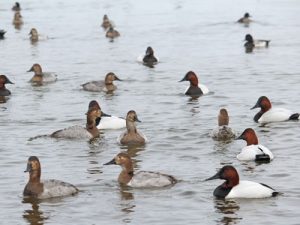 2017 was the third consecutive record-breaking year for underwater grass abundance in Maryland’s portion of Chesapeake Bay, according to Maryland Department of Natural Resources (DNR).
2017 was the third consecutive record-breaking year for underwater grass abundance in Maryland’s portion of Chesapeake Bay, according to Maryland Department of Natural Resources (DNR).
An annual baywide survey showed 62,356 acres of underwater grasses were mapped in Maryland’s tidal waters, a 5 percent increase from 2016.
This is the fifth straight year of expansion for Maryland’s underwater grasses, which surpassed the 2017 restoration goal of 57,000 acres in 2015 and continues to rise.
Baywide, the total acreage of underwater grasses exceeded 100,000 for the first time, reaching 104,843 acres.
Underwater grasses respond quickly to improvements in water quality conditions, making them a critical indicator of restoration progress. Less nutrient pollution leads to improved water clarity, which in turn, allows for increased underwater grass growth.
Also known as submerged aquatic vegetation (SAV), underwater grasses are a critically important bay habitat that remove nutrients and sediment from the water column, reduce shoreline erosion, provide nursery habitat and protection for species like the blue crab and largemouth bass, and support and sustain migrating waterfowl.
In Maryland, all or part of nine rivers surpassed their restoration goals. These included the Big Annemessex River at 155 percent; Chesapeake and Delaware Canal at 255 percent; the tidal fresh portion of the Chester River at 40,996 percent (the percent of the goal attained is so high due to a very small segment restoration goal); the Elk River at 113 percent; Fishing Bay at 186 percent; the Gunpowder River at 140 percent; the Manokin River at 168 percent; and the Northeast River at 113 percent. The mouth of the Choptank River reached 106 percent of its restoration goal in 2017, exceeding the goal for the first time since 1984.
An additional five river segments in Maryland reached 75 percent or more of their restoration goals. In the lower Nanticoke River, underwater grass was observed for the first time since the survey began in 1984.
The rise in underwater grass is attributed not only to a continued expansion of widgeon grass in the moderately salty mid-bay region, but to an expansion of freshwater grasses, like wild celery that grow in the upper reaches of rivers and tidal fresh portions of the bay.
Maryland’s biggest and most iconic underwater grass bed, located in the Susquehanna Flats, has been steadily recovering since 2012, when grass beds were significantly reduced from high flows related to Tropical Storm Lee in 2011, and reached more than 6,100 acres in 2017, showcasing the bed’s continued resilience.
The annual aerial survey was conducted by the Virginia Institute of Marine Science between May and November 2017 and covered 189 flight lines. The aerial imagery is used to identify the amount and location of underwater grasses in the Chesapeake Bay and tidal tributaries. For the first time in years, there were no air space restrictions or weather constraints, so a complete survey of the entire bay was conducted.
source: Maryland Department of Natural Resources
Leave a Reply
You must be logged in to post a comment.